Isotopic variation in Semail Ophiolite lower crust reveals crustal-level melt aggregation
Affiliations | Corresponding Author | Cite as | Funding information- Share this article





Article views:2,799Cumulative count of HTML views and PDF downloads.
- Download Citation
- Rights & Permissions
top
Abstract
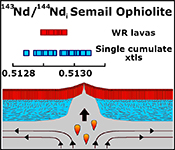
Figures and Tables
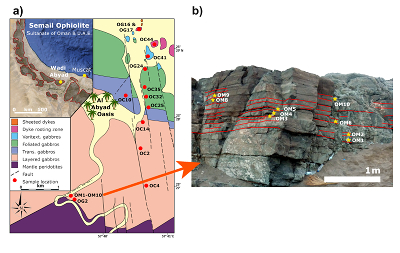 Figure 1 (a) Geological map of the lower crustal section at Wadi Abyad, in the Semail Ophiolite, Oman, with sample locations indicated (after MacLeod and Yaouancq, 2000; sample names were shortened by omitting the numerals ‘95’ preceding the letters ‘OC’ and ‘OG’ and ‘14’ preceding ‘OM’). (b) An outcrop at the base of the layered gabbros was sampled at ~15 cm intervals (one sample per modal layer). | 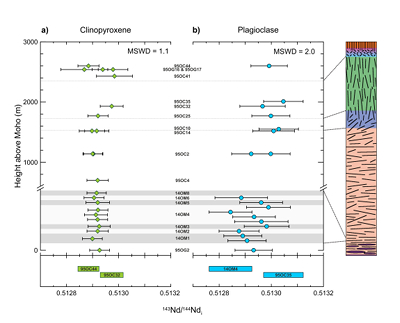 Figure 2 Age-corrected 143Nd/144Ndi of (a) single clinopyroxene and (b) plagioclase crystals in the Abyad section. Clinopyroxene has a near uniform composition whereas plagioclase shows variability outside analytical uncertainty. Grey and white alternating bars at the base of the section indicate the individual modal layers of the sampled layered gabbro outcrop (not to scale). Coloured bars at the bottom of the figure represent the uncertainty for the two most extreme samples. | 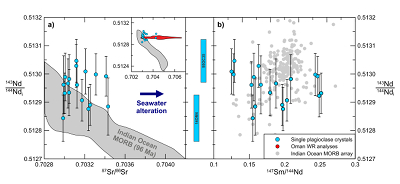 Figure 3 (a) Age-corrected 143Nd/144Ndi and 87Sr/86Sr compositions of plagioclase samples. Indian Ocean MORB data from the PetDB database and age-corrected to 96 Ma using model Sm/Nd and Rb/Sr ratios for depleted MORB mantle (Workman and Hart, 2005). The ranges of whole rock age-corrected Sr and Nd isotope analyses of the plutonic and extrusive series of the Semail Ophiolite are shown in the inset (McCulloch et al., 1980; Godard et al., 2006; Rioux et al., 2012, 2013; de Graaff, 2016). (b) Age-corrected 143Nd/144Ndi and 147Sm/144Nd ratios show no correlation, whereas the present day Indian Ocean MORB array, shown for comparison, displays a broad positive correlation. Coloured bars in the centre panel represent the uncertainty in 143Nd/144Ndi for the two most extreme samples. | 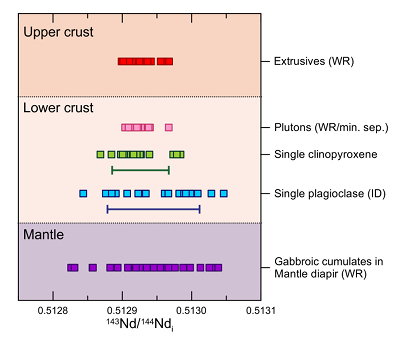 Figure 4 Comparison of the ranges in Nd isotopes found in this study with previous results of the Semail Ophiolite (McCulloch et al., 1980; Benoit et al., 1996; Godard et al., 2006; Rioux et al., 2012, 2013; de Graaff, 2016). Range for repeated analyses of BCR-2 reference material is indicated by the green (1.9-2.6 ng Nd) and blue (0.15-0.34 ng Nd) bars (displayed at an arbitrary position on the x-axis). |
| Figure 1 | Figure 2 | Figure 3 | Figure 4 |
top
Introduction
Planetary differentiation and plate tectonics have led to marked compositional heterogeneity in Earth’s mantle. Quantification of the scale and magnitude of mantle heterogeneity has important implications for the understanding of these processes and is one of the major challenges in geochemistry. Because the mantle cannot be sampled directly, this problem remains unresolved. Mid-ocean ridge basalts (MORB) are the most voluminous magmatic rocks on Earth, continually resurfacing two-thirds of the planet on an approximately 200 Myr timescale. They form through decompression melting of the upper mantle and typically undergo partial crystallisation in crustal magma chambers before being erupted onto the seafloor (e.g., Klein and Langmuir, 1987
Klein, E.M., Langmuir, C.H. (1987) Global correlations of ocean ridge basalt chemistry with axial depth and crustal thickness. Journal of Geophysical Research: Solid Earth 92, 8089-8115.
). Long-lived radiogenic isotopes are insensitive to crystallisation processes and are robust mantle source tracers. Many studies have therefore focused on the isotopic composition of MORB to assess along-ridge mantle heterogeneity (e.g., Zindler et al., 1979Zindler, A., Hart, S.R., Frey, F.A., Jakobsson, S.P. (1979) Nd and Sr isotope ratios and rare earth element abundances in Reykjanes Peninsula basalts evidence for mantle heterogeneity beneath Iceland. Earth and Planetary Science Letters 45, 249-262.
). Magmatic processes at mid-ocean ridges, however, act to homogenise discrete magma batches (e.g., Rubin and Sinton, 2007Rubin, K.H., Sinton, J.M. (2007) Inferences on mid-ocean ridge thermal and magmatic structure from MORB compositions. Earth and Planetary Science Letters 260, 257-276.
), thus obscuring variability at the scale of melt extraction. Homogenisation of isotopic variability is particularly common at fast-spreading ridges, where higher melt production enhances magma mixing and reduces mantle-related variation in MORB compositions (Rubin and Sinton, 2007Rubin, K.H., Sinton, J.M. (2007) Inferences on mid-ocean ridge thermal and magmatic structure from MORB compositions. Earth and Planetary Science Letters 260, 257-276.
). Melt batch-scale heterogeneity is partially preserved in phenocrysts and their melt inclusions, which are believed to record unaggregated melt compositions (e.g., Lange et al., 2013Lange, A.E., Nielsen, R.L., Tepley, F.J., Kent, A.J.R. (2013) Diverse Sr isotope signatures preserved in mid-oceanic-ridge basalt plagioclase. Geology 41, 279–282.
). This suggests that lower crustal cumulates potentially record a greater isotopic variability than their extrusive counterparts.Explicit consideration for the scale of sampling is essential for a full understanding of the lower oceanic crust due to the presence of significant compositional heterogeneity at scales ranging from millimetres to hundreds of metres (e.g., Lissenberg et al., 2013
Lissenberg, C.J., MacLeod, C.J., Howard, K.A., Godard, M. (2013) Pervasive reactive melt migration through fast-spreading lower oceanic crust (Hess Deep, equatorial Pacific Ocean). Earth and Planetary Science Letters 361, 436-447.
; Coogan, 2014Coogan, L.A. (2014) The Lower Oceanic Crust. In: Holland, H.D., Turekian, K.K. (Eds.) Treatise on Geochemistry. Second Edition, Elsevier, Oxford, 497-541.
). Whole rock geochemical analyses cannot resolve sample- or crystal-scale variations. Isotopic heterogeneity within individual minerals is to be expected if crystal growth spans replenishment and magma mixing episodes (Davidson and Tepley, 1997Davidson, J.P., Tepley, F.J. (1997) Recharge in volcanic systems: evidence from isotope profiles of phenocrysts. Science 275, 826-829.
; Lange et al., 2013Lange, A.E., Nielsen, R.L., Tepley, F.J., Kent, A.J.R. (2013) Diverse Sr isotope signatures preserved in mid-oceanic-ridge basalt plagioclase. Geology 41, 279–282.
). Furthermore, whole rock isotopic data may mask heterogeneity if overgrowth on cumulus minerals and/or intercumulus minerals crystallised from isotopically distinct migrating interstitial melts (Yang et al., 2013Yang, S.H, Maier, W.D., Lahaye, Y., O’Brien, H. (2013) Strontium isotope disequilibrium of plagioclase in the Upper Critical Zone of the Bushveld Complex: evidence for mixing of crystal slurries. Contributions to Mineralogy and Petrology 166, 959-974.
).Due to its inaccessibility, oceanic crust is often studied using on-land analogues such as the 96 Ma Semail Ophiolite in Oman and the UAE (Nicolas, 1989
Nicolas, A. (1989) Structures of ophiolites and dynamics of ocean lithosphere. Kluwer Academic Publishers, Dordrecht, 367 pp.
; Rioux et al., 2013Rioux, M., Bowring, S., Kelemen, P., Gordon, S., Miller, R., Dudas, F. (2013) Tectonic development of the Samail ophiolite: High‐precision U‐Pb zircon geochronology and Sm‐Nd isotopic constraints on crustal growth and emplacement. Journal of Geophysical Research: Solid Earth 118, 2085-2101.
). Although the Semail Ophiolite may have formed in a subduction-related setting (MacLeod et al., 2013MacLeod, C.J., Lissenberg, C.J., Bibby, L.E. (2013) “Moist MORB” axial magmatism in the Oman ophiolite: The evidence against a mid-ocean ridge origin. Geology 41, 459-462.
), its mode of formation and isotopic signature is comparable to MORB (Godard et al., 2006Godard, M., Bosch, D., Einaudi, F. (2006) A MORB source for low-Ti magmatism in the Semail ophiolite. Chemical Geology 234, 58-78.
) and therefore an ideal location for this study. A micro-sampling technique for plagioclase and clinopyroxene crystals allowed isotopic analyses of single mineral grains for which the textural context and geochemical composition were known and avoided averaging isotopic variations within a sample.top
Geological Setting and Methods
The Semail Ophiolite lower crust at Wadi Abyad consists of a ~1700 m thick sequence of modally layered gabbros, overlain by non-layered, steeply-foliated gabbros (~650 m) and ~150 m of varitextured gabbros and a ‘dyke rooting zone’ transition into the base of a sheeted dyke complex (MacLeod and Yaouancq, 2000
MacLeod, C.J., Yaouancq, G. (2000) A fossil melt lens in the Oman ophiolite: Implications for magma chamber processes at fast spreading ridges. Earth and Planetary Science Letters 176, 357-373.
). Thirteen gabbros and olivine-gabbros spanning the entire lower crustal stratigraphy were sampled at an average interval of ~200 m, complemented with nine sampled modal layers (~15 cm thick) from a single outcrop near the base of the layered gabbros (Fig. 1). Major and trace element data collected from thick sections by EMP and LA-ICPMS (Supplementary Information, Table S-4a-d) were combined with EDS-SEM major element mapping of polished rock slabs to select domains most suitable for micro-sampling in the latter. Single crystal isotopic analyses (Nd and Sr in plagioclase; Nd in clinopyroxene) were performed on material obtained by micro-drilling individual crystals. The amount of Nd recovered ranged between ~1-5 ng in clinopyroxene and ~0.1-0.5 ng in plagioclase, while ~500 ng Sr was obtained from plagioclase. Plagioclase samples were spiked with a 149Sm-150Nd mixed-spike prior to digestion for Sm/Nd isotope dilution analysis. Chemical separation for Sr, Nd and Sm was performed using standard ion exchange techniques and samples were measured on a Thermo Scientific Triton Plus thermal ionisation mass spectrometer (TIMS), using 1013 Ω amplifiers for the measurement of Sm (50-250 pg) and Nd in the plagioclase samples. Isotope ratios were age-corrected to 96 Ma (subscript “i”; Rioux et al., 2013Rioux, M., Bowring, S., Kelemen, P., Gordon, S., Miller, R., Dudas, F. (2013) Tectonic development of the Samail ophiolite: High‐precision U‐Pb zircon geochronology and Sm‐Nd isotopic constraints on crustal growth and emplacement. Journal of Geophysical Research: Solid Earth 118, 2085-2101.
). The reproducibility (2 SD) of 143Nd/144Nd for BCR-2 reference material is 161 ppm for aliquots of 0.15-0.34 ng Nd and 82 ppm for aliquots of 1.9-2.6 ng Nd. A detailed description of the methods and results for internal and external standards is provided in the Supplementary Information.
Figure 1 (a) Geological map of the lower crustal section at Wadi Abyad, in the Semail Ophiolite, Oman, with sample locations indicated (after MacLeod and Yaouancq, 2000
MacLeod, C.J., Yaouancq, G. (2000) A fossil melt lens in the Oman ophiolite: Implications for magma chamber processes at fast spreading ridges. Earth and Planetary Science Letters 176, 357-373.
; sample names were shortened by omitting the numerals ‘95’ preceding the letters ‘OC’ and ‘OG’ and ‘14’ preceding ‘OM’). (b) An outcrop at the base of the layered gabbros was sampled at ~15 cm intervals (one sample per modal layer).top
Results
Plagioclase and clinopyroxene crystals have 143Nd/144Ndi typical of MORB, with values ranging from 0.512844 to 0.513046 (Figs. 2 and 3, Supplementary Information, Table S-4e). Clinopyroxene samples reveal an almost uniform Nd isotope composition, with a range of 225 ppm and only two samples, from the foliated gabbros and dyke rooting zone, are outside error (by 10 ppm); the ppm notation here indicating the range relative to the average 143Nd/144Ndi of the dataset (0.512936).

Figure 2 Age-corrected 143Nd/144Ndi of (a) single clinopyroxene and (b) plagioclase crystals in the Abyad section. Clinopyroxene has a near uniform composition whereas plagioclase shows variability outside analytical uncertainty. Grey and white alternating bars at the base of the section indicate the individual modal layers of the sampled layered gabbro outcrop (not to scale). Coloured bars at the bottom of the figure represent the uncertainty for the two most extreme samples.

Figure 3 (a) Age-corrected 143Nd/144Ndi and 87Sr/86Sr compositions of plagioclase samples. Indian Ocean MORB data from the PetDB database and age-corrected to 96 Ma using model Sm/Nd and Rb/Sr ratios for depleted MORB mantle (Workman and Hart, 2005
Workman, R.K., Hart, S.R. (2005) Major and trace element composition of the depleted MORB mantle (DMM). Earth and Planetary Science Letters 231, 53-72.
). The ranges of whole rock age-corrected Sr and Nd isotope analyses of the plutonic and extrusive series of the Semail Ophiolite are shown in the inset (McCulloch et al., 1980McCulloch, M.T., Gregory, R.T., Wasserburg, G.J., Taylor Jr, H.P. (1980) A neodymium, strontium, and oxygen isotopic study of the Cretaceous Samail ophiolite and implications for the petrogenesis and seawater-hydrothermal alteration of oceanic crust. Earth and Planetary Science Letters 46, 201-211.
; Godard et al., 2006Godard, M., Bosch, D., Einaudi, F. (2006) A MORB source for low-Ti magmatism in the Semail ophiolite. Chemical Geology 234, 58-78.
; Rioux et al., 2012Rioux, M., Bowring, S., Kelemen, P., Gordon, S., Dudás, F., Miller, R. (2012) Rapid crustal accretion and magma assimilation in the Oman-U.A.E. ophiolite: High precision U-Pb zircon geochronology of the gabbroic crust. Journal of Geophysical Research: Solid Earth 117, B07201.
, 2013Rioux, M., Bowring, S., Kelemen, P., Gordon, S., Miller, R., Dudas, F. (2013) Tectonic development of the Samail ophiolite: High‐precision U‐Pb zircon geochronology and Sm‐Nd isotopic constraints on crustal growth and emplacement. Journal of Geophysical Research: Solid Earth 118, 2085-2101.
; de Graaff, 2016De Graaff, S. (2016) Did the Oman Ophiolite form above a subduction zone? Evidence from widespread later-stage intrusions in the Central and Southeastern Semail Ophiolite. MSc thesis, Vrije Universiteit Amsterdam, 42 pp.
). (b) Age-corrected 143Nd/144Ndi and 147Sm/144Nd ratios show no correlation, whereas the present day Indian Ocean MORB array, shown for comparison, displays a broad positive correlation. Coloured bars in the centre panel represent the uncertainty in 143Nd/144Ndi for the two most extreme samples.Plagioclase samples display a greater range in Nd isotope composition, 395 ppm, with the lowest values outside error of the highest values by up to 88 ppm (Fig. 2). This range is well in excess of the variation found in the extrusive suite of the entire Semail Ophiolite (whole rock; 134 ppm). It is also significantly larger than existing whole rock and mineral separate data for the lower crust (123 ppm). It is, however, comparable to the range found in gabbroic cumulates in the Maqsad mantle harzburgites (whole rock; 414 ppm), which are interpreted to be individual melt batches within a fossil mantle diapir (Benoit et al., 1996
Benoit, M., Polvé, M., Ceuleneer, G. (1996) Trace element and isotopic characterization of mafic cumulates in a fossil mantle diapir (Oman ophiolite). Chemical Geology 134, 199-214.
; Fig. 4, all data sources in figure caption).
Figure 4 Comparison of the ranges in Nd isotopes found in this study with previous results of the Semail Ophiolite (McCulloch et al., 1980
McCulloch, M.T., Gregory, R.T., Wasserburg, G.J., Taylor Jr, H.P. (1980) A neodymium, strontium, and oxygen isotopic study of the Cretaceous Samail ophiolite and implications for the petrogenesis and seawater-hydrothermal alteration of oceanic crust. Earth and Planetary Science Letters 46, 201-211.
; Benoit et al., 1996Benoit, M., Polvé, M., Ceuleneer, G. (1996) Trace element and isotopic characterization of mafic cumulates in a fossil mantle diapir (Oman ophiolite). Chemical Geology 134, 199-214.
; Godard et al., 2006Godard, M., Bosch, D., Einaudi, F. (2006) A MORB source for low-Ti magmatism in the Semail ophiolite. Chemical Geology 234, 58-78.
; Rioux et al., 2012Rioux, M., Bowring, S., Kelemen, P., Gordon, S., Dudás, F., Miller, R. (2012) Rapid crustal accretion and magma assimilation in the Oman-U.A.E. ophiolite: High precision U-Pb zircon geochronology of the gabbroic crust. Journal of Geophysical Research: Solid Earth 117, B07201.
, 2013Rioux, M., Bowring, S., Kelemen, P., Gordon, S., Miller, R., Dudas, F. (2013) Tectonic development of the Samail ophiolite: High‐precision U‐Pb zircon geochronology and Sm‐Nd isotopic constraints on crustal growth and emplacement. Journal of Geophysical Research: Solid Earth 118, 2085-2101.
; de Graaff, 2016De Graaff, S. (2016) Did the Oman Ophiolite form above a subduction zone? Evidence from widespread later-stage intrusions in the Central and Southeastern Semail Ophiolite. MSc thesis, Vrije Universiteit Amsterdam, 42 pp.
). Range for repeated analyses of BCR-2 reference material is indicated by the green (1.9-2.6 ng Nd) and blue (0.15-0.34 ng Nd) bars (displayed at an arbitrary position on the x-axis).The plagioclase Nd data (n = 19) yield a mean square weighted deviation (MSWD = 2.0) that is significantly greater than the critical value (1.7; following Wendt and Carl, 1991
Wendt, I., Carl, C. (1991) The statistical distribution of the mean squared weighted deviation. Chemical Geology: Isotope Geoscience section 86, 275-285.
; see Supplementary Information), meaning that the probability that the data form a single, normally distributed population is <5 %. We therefore argue that the observed 143Nd/144Ndi heterogeneity in plagioclase is statistically significant and represents a primary feature. The clinopyroxene data (n = 22) show an MSWD that is smaller than the critical MSWD (1.1 versus 1.6, respectively), implying that the clinopyroxene data constitute a statistically homogeneous population at the current level of precision.There is no discernible stratigraphic trend in plagioclase isotopic composition and the samples record a relatively large range in 147Sm/144Nd ratios (0.13-0.25) that does not correlate with 143Nd/144Ndi (Fig. 3). With the exception of two samples, Nd and Sr isotope ratios in plagioclase crystals are closer to the MORB array than whole rock isotopic analyses (red field in Fig. 3). It is difficult to interpret the variability of strontium isotopes in plagioclase purely in terms of mantle source as seawater alteration is known to elevate 87Sr/86Sr without affecting 143Nd/144Nd (McCulloch et al., 1980
McCulloch, M.T., Gregory, R.T., Wasserburg, G.J., Taylor Jr, H.P. (1980) A neodymium, strontium, and oxygen isotopic study of the Cretaceous Samail ophiolite and implications for the petrogenesis and seawater-hydrothermal alteration of oceanic crust. Earth and Planetary Science Letters 46, 201-211.
). The limited range observed in the micro-drilled 87Sr/86Sr compositions potentially records less extensive seawater alteration but we cannot disentangle minor alteration from source heterogeneity.top
Discussion
Our data represent the first micro-drilled Nd isotope mineral analyses for lower ocean crustal rocks and provide constraints on both ocean crustal and mantle processes. Compared to previous whole rock analyses of plutonic rocks, single plagioclase crystals record a larger Nd isotope variability and are thus much more suitable for studying the full extent of isotopic variability in the lower oceanic crust. The similarity of the observed Nd isotope range in plagioclase to the gabbros from the Maqsad diapir (Fig. 4), taken to represent individual melt batches in upwelling mantle (Benoit et al., 1996
Benoit, M., Polvé, M., Ceuleneer, G. (1996) Trace element and isotopic characterization of mafic cumulates in a fossil mantle diapir (Oman ophiolite). Chemical Geology 134, 199-214.
), suggests that the lower crust preserves the heterogeneity of melt batches at a mineral scale. This implies that the upper mantle is compositionally heterogeneous at the scale of melt extraction (e.g., Lange et al., 2013Lange, A.E., Nielsen, R.L., Tepley, F.J., Kent, A.J.R. (2013) Diverse Sr isotope signatures preserved in mid-oceanic-ridge basalt plagioclase. Geology 41, 279–282.
), and that the melt extraction process did not fully homogenise melts. The isotopic variability in whole rock analyses of the overlying dykes and lavas, representing fully aggregated and erupted melts, is limited compared to plagioclase in the lower crust (Fig. 4) and indicates that the substantial mixing and homogenisation required to produce MORB takes place in the crust. Previous comparisons of upper crustal basalts to whole rock analyses of plutonic rocks led to a substantially different conclusion as illustrated in Figure 4 (e.g., Coogan, 2014Coogan, L.A. (2014) The Lower Oceanic Crust. In: Holland, H.D., Turekian, K.K. (Eds.) Treatise on Geochemistry. Second Edition, Elsevier, Oxford, 497-541.
). The whole rock data alone suggest the upper and lower crust formed from melts that were homogenised to similar extents. Our findings also contrast with Koga et al. (2001)Koga, K.T., Kelemen, P.B., Shimizu, N. (2001) Petrogenesis of the crust-mantle transition zone and the origin of lower crustal wehrlite in the Oman ophiolite. Geochemistry, Geophysics, Geosystems 2, 2000GC000132.
who concluded that trace element variability in the Moho transition zone in the Semail Ophiolite is comparable to that in the upper crustal sheeted dyke complex and lavas and that mixing must have taken place predominantly in the mantle.This study demonstrates that the approach of using mineral trace element ratios alone to study source compositions can be problematic. We find that plagioclase Sm/Nd does not correlate with 143Nd/144Ndi (the time integrated Sm/Nd), whereas a positive correlation would be expected if Sm/Nd is inherited from a mantle source (Fig. 3). Several other processes can affect Sm/Nd, such as degree of mantle melting, fractional crystallisation, melt replenishment (O’Neill and Jenner, 2012
O'Neill, H., Jenner, F.E. (2012) The global pattern of trace-element distributions in ocean floor basalts. Nature 491, 698-704.
), melt-rock reactions (Lissenberg and MacLeod, 2016Lissenberg, C.J., MacLeod, C.J. (2016) A Reactive Porous Flow Control on Mid-ocean Ridge Magmatic Evolution. Journal of Petrology 57, 2195-2220.
) and variable partition coefficients due to changes in pressure, An %, pH2O and melt composition (Bédard, 2006Bédard, J.H. (2006) Trace element partitioning in plagioclase feldspar. Geochimica et Cosmochimica Acta 70, 3717-3742.
). Hence, it is difficult to interpret a source signature from plagioclase trace element compositions. Since Nd isotope ratios are not fractionated by these processes, they are uniquely suited for investigating sources of mantle derived melt.The contrast in 143Nd/144Ndi variability between clinopyroxene (homogeneous) and plagioclase (heterogeneous) can have multiple causes. The first is sub-solidus diffusion of REE. This unlikely to be responsible for homogenisation, however, since Nd diffusion coefficients of clinopyroxene are two orders of magnitude lower than plagioclase (van Orman et al., 2001
van Orman, J., Grove, T., Shimizu, N. (2001) Rare earth element diffusion in diopside: influence of temperature, pressure, and ionic radius, and an elastic model for diffusion in silicates. Contributions to Mineralogy and Petrology 141, 687-703.
; Cherniak, 2003Cherniak, D.J. (2003) REE diffusion in feldspar. Chemical Geology 193, 25-41.
) and modelling shows that diffusion would primarily affect plagioclase rather than clinopyroxene for conditions prevalent in the lower oceanic crust (Coogan and O’Hara, 2015Coogan, L.A., O’Hara, M.J. (2015) MORB differentiation: In situ crystallization in replenished-tapped magma chambers. Geochimica et Cosmochimica Acta 158, 147-161.
).The second is a crystallisation sequence of plagioclase before clinopyroxene during progressive magma mixing and associated homogenisation. Textures of Wadi Abyad gabbros are granular to intergranular, with an apparent olivine -> plagioclase -> clinopyroxene crystallisation sequence. The absence of troctolites in the section, however, may indicate a near simultaneous saturation of plagioclase and clinopyroxene (Thomas, 2003
Thomas, R. M. (2003) Processes of lower crustal accretion beneath intermediate- to fast-spreading ocean ridges: constraints from the Wadi Abyad section of the Oman ophiolite. PhD thesis, Cardiff University, 497 pp.
). Furthermore, moderate textural re-equilibration during slow cooling may obscure primary textures and make it difficult to distinguish co-crystallisation from sequential crystallisation (MacLeod and Yaouancq, 2000MacLeod, C.J., Yaouancq, G. (2000) A fossil melt lens in the Oman ophiolite: Implications for magma chamber processes at fast spreading ridges. Earth and Planetary Science Letters 176, 357-373.
).Finally, reactive porous flow of interstitial melts may be responsible for isotopic homogenisation in clinopyroxene. Migration of late stage melts by porous flow is pervasive throughout the entire lower crust (Lissenberg et al., 2013
Lissenberg, C.J., MacLeod, C.J., Howard, K.A., Godard, M. (2013) Pervasive reactive melt migration through fast-spreading lower oceanic crust (Hess Deep, equatorial Pacific Ocean). Earth and Planetary Science Letters 361, 436-447.
; Lissenberg and MacLeod, 2016Lissenberg, C.J., MacLeod, C.J. (2016) A Reactive Porous Flow Control on Mid-ocean Ridge Magmatic Evolution. Journal of Petrology 57, 2195-2220.
). Clinopyroxene and plagioclase in gabbros at Wadi Abyad show features that have been ascribed to reactive porous flow, including an up-section increase in enrichment and fractionation of elements proportional to their incompatibility (e.g., La/Nd and Ce/Y) and trace element disequilibrium between coexisting plagioclase and clinopyroxene (Lissenberg and MacLeod, 2016Lissenberg, C.J., MacLeod, C.J. (2016) A Reactive Porous Flow Control on Mid-ocean Ridge Magmatic Evolution. Journal of Petrology 57, 2195-2220.
). If the migrating interstitial melts are isotopically homogeneous, as seems likely, melt-crystal reaction can conceivably homogenise isotopic variation in the lower crust. It is currently unclear, however, whether clinopyroxene is more sensitive to melt-rock reactions than plagioclase, as would be implied by the data: further work on this subject is required.This work demonstrates that isotopic analysis of single grains in plutonic rocks has great potential to study the scale of mantle heterogeneity and the nature of crustal processes. By establishing that greater variability exists in the lower crust than in the erupted lavas of the Semail Ophiolite, we have shown that isotopic studies of whole rock MORB mask the full scale and extent of compositional heterogeneity of the mantle source. Micro-sampling successfully avoids interstitial grains and domains most affected by alteration (i.e. crystal rims) and, with the latest generation of sensitive amplifier technology, yields enough material to identify isotopic variability. Future research should employ these techniques to investigate further the presence of stratigraphic trends on various scales and isotopic disequilibrium between clinopyroxene and plagioclase. A better understanding of the variability of isotopic composition in the lower oceanic crust has implications for the location of melt emplacement and the location and extent of magma mixing at oceanic spreading centres, as well as the scale and magnitude of mantle heterogeneity.
top
Acknowledgements
The authors would like to thank Sergei Matveev and Jasper Berndt for their technical assistance with EMP and LA-ICPMS analyses. Chris Coath is thanked for his help with data treatment. Kathryn Goodenough, Michael Styles and David Schofield of the British Geological Survey are thanked for their help in the field. We wish to thank two anonymous reviewers and editor Cin-Ty Lee for their constructive comments that helped improve the manuscript.
Editor: Cin-Ty Lee
top
References
Bédard, J.H. (2006) Trace element partitioning in plagioclase feldspar. Geochimica et Cosmochimica Acta 70, 3717-3742.
 Show in context
Show in context Several other processes can affect Sm/Nd, such as degree of mantle melting, fractional crystallisation, melt replenishment (O’Neill and Jenner, 2012), melt-rock reactions (Lissenberg and MacLeod, 2016) and variable partition coefficients due to changes in pressure, An %, pH2O and melt composition (Bédard, 2006).
View in article
Benoit, M., Polvé, M., Ceuleneer, G. (1996) Trace element and isotopic characterization of mafic cumulates in a fossil mantle diapir (Oman ophiolite). Chemical Geology 134, 199-214.
 Show in context
Show in context It is, however, comparable to the range found in gabbroic cumulates in the Maqsad mantle harzburgites (whole rock; 414 ppm), which are interpreted to be individual melt batches within a fossil mantle diapir (Benoit et al., 1996; Fig. 4, all data sources in figure caption).
View in article
Figure 4 [...] Comparison of the ranges in Nd isotopes found in this study with previous results of the Semail Ophiolite (McCulloch et al., 1980; Benoit et al., 1996; Godard et al., 2006; Rioux et al., 2012, 2013; de Graaff, 2016).
View in article
The similarity of the observed Nd isotope range in plagioclase to the gabbros from the Maqsad diapir ( Fig. 4), taken to represent individual melt batches in upwelling mantle (Benoit et al., 1996), suggests that the lower crust preserves the heterogeneity of melt batches at a mineral scale.
View in article
Cherniak, D.J. (2003) REE diffusion in feldspar. Chemical Geology 193, 25-41.
 Show in context
Show in context This unlikely to be responsible for homogenisation, however, since Nd diffusion coefficients of clinopyroxene are two orders of magnitude lower than plagioclase (van Orman et al., 2001; Cherniak, 2003) and modelling shows that diffusion would primarily affect plagioclase rather than clinopyroxene for conditions prevalent in the lower oceanic crust (Coogan and O’Hara, 2015).
View in article
Coogan, L.A. (2014) The Lower Oceanic Crust. In: Holland, H.D., Turekian, K.K. (Eds.) Treatise on Geochemistry. Second Edition, Elsevier, Oxford, 497-541.
 Show in context
Show in context Explicit consideration for the scale of sampling is essential for a full understanding of the lower oceanic crust due to the presence of significant compositional heterogeneity at scales ranging from millimetres to hundreds of metres (e.g., Lissenberg et al., 2013; Coogan, 2014).
View in article
Previous comparisons of upper crustal basalts to whole rock analyses of plutonic rocks led to a substantially different conclusion as illustrated in Figure 4 (e.g., Coogan, 2014).
View in article
Coogan, L.A., O’Hara, M.J. (2015) MORB differentiation: In situ crystallization in replenished-tapped magma chambers. Geochimica et Cosmochimica Acta 158, 147-161.
 Show in context
Show in context This unlikely to be responsible for homogenisation, however, since Nd diffusion coefficients of clinopyroxene are two orders of magnitude lower than plagioclase (van Orman et al., 2001; Cherniak, 2003) and modelling shows that diffusion would primarily affect plagioclase rather than clinopyroxene for conditions prevalent in the lower oceanic crust (Coogan and O’Hara, 2015).
View in article
Davidson, J.P., Tepley, F.J. (1997) Recharge in volcanic systems: evidence from isotope profiles of phenocrysts. Science 275, 826-829.
 Show in context
Show in context Isotopic heterogeneity within individual minerals is to be expected if crystal growth spans replenishment and magma mixing episodes (Davidson and Tepley, 1997; Lange et al., 2013).
View in article
Godard, M., Bosch, D., Einaudi, F. (2006) A MORB source for low-Ti magmatism in the Semail ophiolite. Chemical Geology 234, 58-78.
 Show in context
Show in context Although the Semail Ophiolite may have formed in a subduction-related setting (MacLeod et al., 2013), its mode of formation and isotopic signature is comparable to MORB (Godard et al., 2006) and therefore an ideal location for this study.
View in article
Figure 3 [...] The ranges of whole rock age-corrected Sr and Nd isotope analyses of the plutonic and extrusive series of the Semail Ophiolite are shown in the inset (McCulloch et al., 1980; Godard et al., 2006; Rioux et al., 2012, 2013; de Graaff, 2016).
View in article
Figure 4 [...] Comparison of the ranges in Nd isotopes found in this study with previous results of the Semail Ophiolite (McCulloch et al., 1980; Benoit et al., 1996; Godard et al., 2006; Rioux et al., 2012, 2013; de Graaff, 2016).
View in article
De Graaff, S. (2016) Did the Oman Ophiolite form above a subduction zone? Evidence from widespread later-stage intrusions in the Central and Southeastern Semail Ophiolite. MSc thesis, Vrije Universiteit Amsterdam, 42 pp.
 Show in context
Show in contextFigure 3 [...] The ranges of whole rock age-corrected Sr and Nd isotope analyses of the plutonic and extrusive series of the Semail Ophiolite are shown in the inset (McCulloch et al., 1980; Godard et al., 2006; Rioux et al., 2012, 2013; de Graaff, 2016).
View in article
Figure 4 [...] Comparison of the ranges in Nd isotopes found in this study with previous results of the Semail Ophiolite (McCulloch et al., 1980; Benoit et al., 1996; Godard et al., 2006; Rioux et al., 2012, 2013; de Graaff, 2016).
View in article
Klein, E.M., Langmuir, C.H. (1987) Global correlations of ocean ridge basalt chemistry with axial depth and crustal thickness. Journal of Geophysical Research: Solid Earth 92, 8089-8115.
 Show in context
Show in contextThey form through decompression melting of the upper mantle and typically undergo partial crystallisation in crustal magma chambers before being erupted onto the seafloor (e.g., Klein and Langmuir, 1987).
View in article
Koga, K.T., Kelemen, P.B., Shimizu, N. (2001) Petrogenesis of the crust-mantle transition zone and the origin of lower crustal wehrlite in the Oman ophiolite. Geochemistry, Geophysics, Geosystems 2, 2000GC000132.
 Show in context
Show in context Our findings also contrast with Koga et al. (2001) who concluded that trace element variability in the Moho transition zone in the Semail Ophiolite is comparable to that in the upper crustal sheeted dyke complex and lavas and that mixing must have taken place predominantly in the mantle.
View in article
Lange, A.E., Nielsen, R.L., Tepley, F.J., Kent, A.J.R. (2013) Diverse Sr isotope signatures preserved in mid-oceanic-ridge basalt plagioclase. Geology 41, 279–282.
 Show in context
Show in context Melt batch-scale heterogeneity is partially preserved in phenocrysts and their melt inclusions, which are believed to record unaggregated melt compositions (e.g., Lange et al., 2013).
View in article
Isotopic heterogeneity within individual minerals is to be expected if crystal growth spans replenishment and magma mixing episodes (Davidson and Tepley, 1997; Lange et al., 2013).
View in article
This implies that the upper mantle is compositionally heterogeneous at the scale of melt extraction (e.g., Lange et al., 2013), and that the melt extraction process did not fully homogenise melts.
View in article
Lissenberg, C.J., MacLeod, C.J. (2016) A Reactive Porous Flow Control on Mid-ocean Ridge Magmatic Evolution. Journal of Petrology 57, 2195-2220.
 Show in context
Show in context Several other processes can affect Sm/Nd, such as degree of mantle melting, fractional crystallisation, melt replenishment (O’Neill and Jenner, 2012), melt-rock reactions (Lissenberg and MacLeod, 2016) and variable partition coefficients due to changes in pressure, An %, pH2O and melt composition (Bédard, 2006).
View in article
Finally, reactive porous flow of interstitial melts may be responsible for isotopic homogenisation in clinopyroxene. Migration of late stage melts by porous flow is pervasive throughout the entire lower crust (Lissenberg et al., 2013; Lissenberg and MacLeod, 2016).
View in article
Clinopyroxene and plagioclase in gabbros at Wadi Abyad show features that have been ascribed to reactive porous flow, including an up-section increase in enrichment and fractionation of elements proportional to their incompatibility (e.g., La/Nd and Ce/Y) and trace element disequilibrium between coexisting plagioclase and clinopyroxene (Lissenberg and MacLeod, 2016).
View in article
Lissenberg, C.J., MacLeod, C.J., Howard, K.A., Godard, M. (2013) Pervasive reactive melt migration through fast-spreading lower oceanic crust (Hess Deep, equatorial Pacific Ocean). Earth and Planetary Science Letters 361, 436-447.
 Show in context
Show in context Explicit consideration for the scale of sampling is essential for a full understanding of the lower oceanic crust due to the presence of significant compositional heterogeneity at scales ranging from millimetres to hundreds of metres (e.g., Lissenberg et al., 2013; Coogan, 2014).
View in article
Finally, reactive porous flow of interstitial melts may be responsible for isotopic homogenisation in clinopyroxene. Migration of late stage melts by porous flow is pervasive throughout the entire lower crust (Lissenberg et al., 2013; Lissenberg and MacLeod, 2016).
View in article
MacLeod, C.J., Yaouancq, G. (2000) A fossil melt lens in the Oman ophiolite: Implications for magma chamber processes at fast spreading ridges. Earth and Planetary Science Letters 176, 357-373.
 Show in context
Show in context The Semail Ophiolite lower crust at Wadi Abyad consists of a ~1700 m thick sequence of modally layered gabbros, overlain by non-layered, steeply-foliated gabbros (~650 m) and ~150 m of varitextured gabbros and a ‘dyke rooting zone’ transition into the base of a sheeted dyke complex (MacLeod and Yaouancq, 2000).
View in article
Figure 1 (a) Geological map of the lower crustal section at Wadi Abyad, in the Semail Ophiolite, Oman, with sample locations indicated (after MacLeod and Yaouancq, 2000; sample names were shortened by omitting the numerals ‘95’ preceding the letters ‘OC’ and ‘OG’ and ‘14’ preceding ‘OM’).
View in article
Furthermore, moderate textural re-equilibration during slow cooling may obscure primary textures and make it difficult to distinguish co-crystallisation from sequential crystallisation (MacLeod and Yaouancq, 2000).
View in article
MacLeod, C.J., Lissenberg, C.J., Bibby, L.E. (2013) “Moist MORB” axial magmatism in the Oman ophiolite: The evidence against a mid-ocean ridge origin. Geology 41, 459-462.
 Show in context
Show in contextAlthough the Semail Ophiolite may have formed in a subduction-related setting (MacLeod et al., 2013), its mode of formation and isotopic signature is comparable to MORB (Godard et al., 2006) and therefore an ideal location for this study.
View in article
McCulloch, M.T., Gregory, R.T., Wasserburg, G.J., Taylor Jr, H.P. (1980) A neodymium, strontium, and oxygen isotopic study of the Cretaceous Samail ophiolite and implications for the petrogenesis and seawater-hydrothermal alteration of oceanic crust. Earth and Planetary Science Letters 46, 201-211.
 Show in context
Show in context Figure 3 [...] The ranges of whole rock age-corrected Sr and Nd isotope analyses of the plutonic and extrusive series of the Semail Ophiolite are shown in the inset (McCulloch et al., 1980; Godard et al., 2006; Rioux et al., 2012, 2013; de Graaff, 2016).
View in article
Figure 4 [...] Comparison of the ranges in Nd isotopes found in this study with previous results of the Semail Ophiolite (McCulloch et al., 1980; Benoit et al., 1996; Godard et al., 2006; Rioux et al., 2012, 2013; de Graaff, 2016).
View in article
It is difficult to interpret the variability of strontium isotopes in plagioclase purely in terms of mantle source as seawater alteration is known to elevate 87Sr/86Sr without affecting 143Nd/144Nd (McCulloch et al., 1980).
View in article
Nicolas, A. (1989) Structures of ophiolites and dynamics of ocean lithosphere. Kluwer Academic Publishers, Dordrecht, 367 pp.
 Show in context
Show in contextDue to its inaccessibility, oceanic crust is often studied using on-land analogues such as the 96 Ma Semail Ophiolite in Oman and the UAE (Nicolas, 1989; Rioux et al., 2013).
View in article
O'Neill, H., Jenner, F.E. (2012) The global pattern of trace-element distributions in ocean floor basalts. Nature 491, 698-704.
 Show in context
Show in context Several other processes can affect Sm/Nd, such as degree of mantle melting, fractional crystallisation, melt replenishment (O’Neill and Jenner, 2012), melt-rock reactions (Lissenberg and MacLeod, 2016) and variable partition coefficients due to changes in pressure, An %, pH2O and melt composition (Bédard, 2006).
View in article
Rioux, M., Bowring, S., Kelemen, P., Gordon, S., Dudás, F., Miller, R. (2012) Rapid crustal accretion and magma assimilation in the Oman-U.A.E. ophiolite: High precision U-Pb zircon geochronology of the gabbroic crust. Journal of Geophysical Research: Solid Earth 117, B07201.
 Show in context
Show in context Figure 3 [...] The ranges of whole rock age-corrected Sr and Nd isotope analyses of the plutonic and extrusive series of the Semail Ophiolite are shown in the inset (McCulloch et al., 1980; Godard et al., 2006; Rioux et al., 2012, 2013; de Graaff, 2016).
View in article
Figure 4 [...] Comparison of the ranges in Nd isotopes found in this study with previous results of the Semail Ophiolite (McCulloch et al., 1980; Benoit et al., 1996; Godard et al., 2006; Rioux et al., 2012, 2013; de Graaff, 2016).
View in article
Rioux, M., Bowring, S., Kelemen, P., Gordon, S., Miller, R., Dudas, F. (2013) Tectonic development of the Samail ophiolite: High‐precision U‐Pb zircon geochronology and Sm‐Nd isotopic constraints on crustal growth and emplacement. Journal of Geophysical Research: Solid Earth 118, 2085-2101.
 Show in context
Show in context Due to its inaccessibility, oceanic crust is often studied using on-land analogues such as the 96 Ma Semail Ophiolite in Oman and the UAE (Nicolas, 1989; Rioux et al., 2013).
View in article
Isotope ratios were age-corrected to 96 Ma (subscript “i”; Rioux et al., 2013).
View in article
Figure 3 [...] The ranges of whole rock age-corrected Sr and Nd isotope analyses of the plutonic and extrusive series of the Semail Ophiolite are shown in the inset (McCulloch et al., 1980; Godard et al., 2006; Rioux et al., 2012, 2013; de Graaff, 2016).
View in article
Figure 4 [...] Comparison of the ranges in Nd isotopes found in this study with previous results of the Semail Ophiolite (McCulloch et al., 1980; Benoit et al., 1996; Godard et al., 2006; Rioux et al., 2012, 2013; de Graaff, 2016).
View in article
Rubin, K.H., Sinton, J.M. (2007) Inferences on mid-ocean ridge thermal and magmatic structure from MORB compositions. Earth and Planetary Science Letters 260, 257-276.
 Show in context
Show in context Magmatic processes at mid-ocean ridges, however, act to homogenise discrete magma batches (e.g., Rubin and Sinton, 2007), thus obscuring variability at the scale of melt extraction.
View in article
Homogenisation of isotopic variability is particularly common at fast-spreading ridges, where higher melt production enhances magma mixing and reduces mantle-related variation in MORB compositions (Rubin and Sinton, 2007).
View in article
Thomas, R. M. (2003) Processes of lower crustal accretion beneath intermediate- to fast-spreading ocean ridges: constraints from the Wadi Abyad section of the Oman ophiolite. PhD thesis, Cardiff University, 497 pp.
 Show in context
Show in context The absence of troctolites in the section, however, may indicate a near simultaneous saturation of plagioclase and clinopyroxene (Thomas, 2003).
View in article
van Orman, J., Grove, T., Shimizu, N. (2001) Rare earth element diffusion in diopside: influence of temperature, pressure, and ionic radius, and an elastic model for diffusion in silicates. Contributions to Mineralogy and Petrology 141, 687-703.
 Show in context
Show in context This unlikely to be responsible for homogenisation, however, since Nd diffusion coefficients of clinopyroxene are two orders of magnitude lower than plagioclase (van Orman et al., 2001; Cherniak, 2003) and modelling shows that diffusion would primarily affect plagioclase rather than clinopyroxene for conditions prevalent in the lower oceanic crust (Coogan and O’Hara, 2015).
View in article
Wendt, I., Carl, C. (1991) The statistical distribution of the mean squared weighted deviation. Chemical Geology: Isotope Geoscience section 86, 275-285.
 Show in context
Show in context The plagioclase Nd data (n = 19) yield a mean square weighted deviation (MSWD = 2.0) that is significantly greater than the critical value (1.7; following Wendt and Carl, 1991; see Supplementary Information), meaning that the probability that the data form a single, normally distributed population is <5 %.
View in article
Workman, R.K., Hart, S.R. (2005) Major and trace element composition of the depleted MORB mantle (DMM). Earth and Planetary Science Letters 231, 53-72.
 Show in context
Show in contextFigure 3 [...] Indian Ocean MORB data from the PetDB database and age-corrected to 96 Ma using model Sm/Nd and Rb/Sr ratios for depleted MORB mantle (Workman and Hart, 2005).
View in article
Yang, S.H, Maier, W.D., Lahaye, Y., O’Brien, H. (2013) Strontium isotope disequilibrium of plagioclase in the Upper Critical Zone of the Bushveld Complex: evidence for mixing of crystal slurries. Contributions to Mineralogy and Petrology 166, 959-974.
 Show in context
Show in context Furthermore, whole rock isotopic data may mask heterogeneity if overgrowth on cumulus minerals and/or intercumulus minerals crystallised from isotopically distinct migrating interstitial melts (Yang et al., 2013).
View in article
Zindler, A., Hart, S.R., Frey, F.A., Jakobsson, S.P. (1979) Nd and Sr isotope ratios and rare earth element abundances in Reykjanes Peninsula basalts evidence for mantle heterogeneity beneath Iceland. Earth and Planetary Science Letters 45, 249-262.
 Show in context
Show in context Many studies have therefore focused on the isotopic composition of MORB to assess along-ridge mantle heterogeneity (e.g., Zindler et al., 1979).
View in article
top
Supplementary Information
The Supplementary Information includes:
- Extended Analytical Techniques and Data Treatment
- Tables S-1 to S-3
- Figures S-1 and S-2
- Supplementary Data Table (Table S-4)
- Supplementary Information References
Download the Supplementary Information (PDF).
Download Table S-4 (Excel).
Figures and Tables
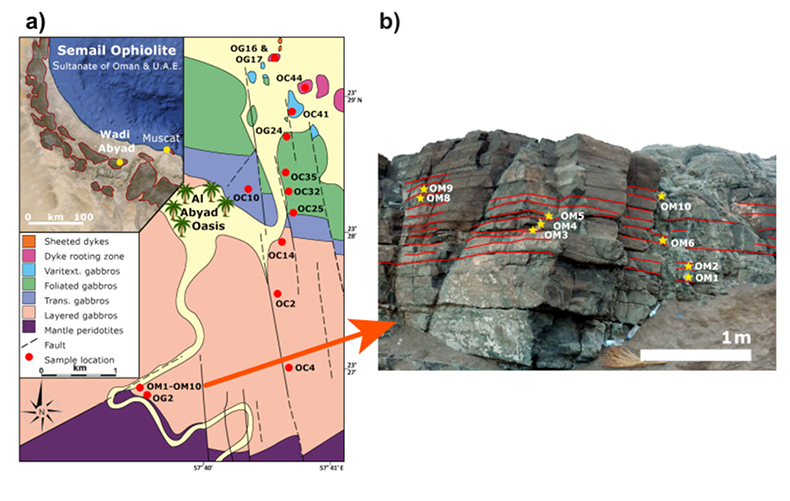
Figure 1 (a) Geological map of the lower crustal section at Wadi Abyad, in the Semail Ophiolite, Oman, with sample locations indicated (after MacLeod and Yaouancq, 2000
MacLeod, C.J., Yaouancq, G. (2000) A fossil melt lens in the Oman ophiolite: Implications for magma chamber processes at fast spreading ridges. Earth and Planetary Science Letters 176, 357-373.
; sample names were shortened by omitting the numerals ‘95’ preceding the letters ‘OC’ and ‘OG’ and ‘14’ preceding ‘OM’). (b) An outcrop at the base of the layered gabbros was sampled at ~15 cm intervals (one sample per modal layer).
Figure 2 Age-corrected 143Nd/144Ndi of (a) single clinopyroxene and (b) plagioclase crystals in the Abyad section. Clinopyroxene has a near uniform composition whereas plagioclase shows variability outside analytical uncertainty. Grey and white alternating bars at the base of the section indicate the individual modal layers of the sampled layered gabbro outcrop (not to scale). Coloured bars at the bottom of the figure represent the uncertainty for the two most extreme samples.
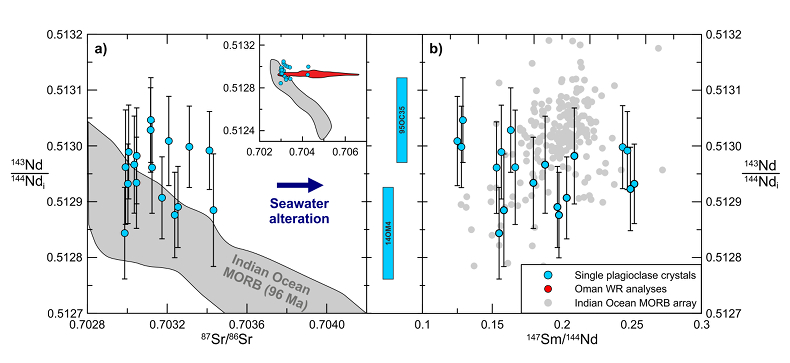
Figure 3 (a) Age-corrected 143Nd/144Ndi and 87Sr/86Sr compositions of plagioclase samples. Indian Ocean MORB data from the PetDB database and age-corrected to 96 Ma using model Sm/Nd and Rb/Sr ratios for depleted MORB mantle (Workman and Hart, 2005
Workman, R.K., Hart, S.R. (2005) Major and trace element composition of the depleted MORB mantle (DMM). Earth and Planetary Science Letters 231, 53-72.
). The ranges of whole rock age-corrected Sr and Nd isotope analyses of the plutonic and extrusive series of the Semail Ophiolite are shown in the inset (McCulloch et al., 1980McCulloch, M.T., Gregory, R.T., Wasserburg, G.J., Taylor Jr, H.P. (1980) A neodymium, strontium, and oxygen isotopic study of the Cretaceous Samail ophiolite and implications for the petrogenesis and seawater-hydrothermal alteration of oceanic crust. Earth and Planetary Science Letters 46, 201-211.
; Godard et al., 2006; Rioux et al., 2012Rioux, M., Bowring, S., Kelemen, P., Gordon, S., Dudás, F., Miller, R. (2012) Rapid crustal accretion and magma assimilation in the Oman-U.A.E. ophiolite: High precision U-Pb zircon geochronology of the gabbroic crust. Journal of Geophysical Research: Solid Earth 117, B07201.
, 2013Rioux, M., Bowring, S., Kelemen, P., Gordon, S., Miller, R., Dudas, F. (2013) Tectonic development of the Samail ophiolite: High‐precision U‐Pb zircon geochronology and Sm‐Nd isotopic constraints on crustal growth and emplacement. Journal of Geophysical Research: Solid Earth 118, 2085-2101.
; de Graaff, 2016De Graaff, S. (2016) Did the Oman Ophiolite form above a subduction zone? Evidence from widespread later-stage intrusions in the Central and Southeastern Semail Ophiolite. MSc thesis, Vrije Universiteit Amsterdam, 42 pp.
). (b) Age-corrected 143Nd/144Ndi and 147Sm/144Nd ratios show no correlation, whereas the present day Indian Ocean MORB array, shown for comparison, displays a broad positive correlation. Coloured bars in the centre panel represent the uncertainty in 143Nd/144Ndi for the two most extreme samples.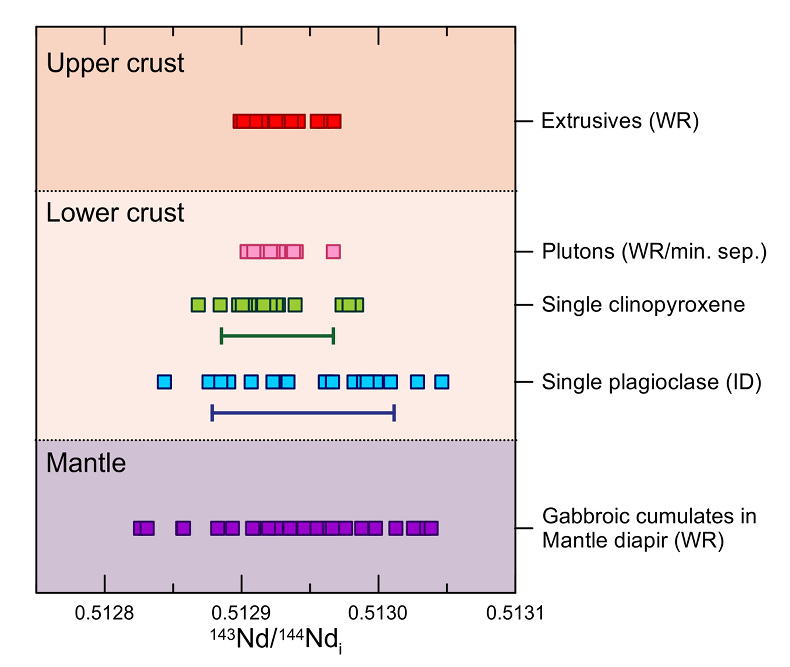
Figure 4 Comparison of the ranges in Nd isotopes found in this study with previous results of the Semail Ophiolite (McCulloch et al., 1980
McCulloch, M.T., Gregory, R.T., Wasserburg, G.J., Taylor Jr, H.P. (1980) A neodymium, strontium, and oxygen isotopic study of the Cretaceous Samail ophiolite and implications for the petrogenesis and seawater-hydrothermal alteration of oceanic crust. Earth and Planetary Science Letters 46, 201-211.
; Benoit et al., 1996Benoit, M., Polvé, M., Ceuleneer, G. (1996) Trace element and isotopic characterization of mafic cumulates in a fossil mantle diapir (Oman ophiolite). Chemical Geology 134, 199-214.
; Godard et al., 2006; Rioux et al., 2012Rioux, M., Bowring, S., Kelemen, P., Gordon, S., Dudás, F., Miller, R. (2012) Rapid crustal accretion and magma assimilation in the Oman-U.A.E. ophiolite: High precision U-Pb zircon geochronology of the gabbroic crust. Journal of Geophysical Research: Solid Earth 117, B07201.
, 2013Rioux, M., Bowring, S., Kelemen, P., Gordon, S., Miller, R., Dudas, F. (2013) Tectonic development of the Samail ophiolite: High‐precision U‐Pb zircon geochronology and Sm‐Nd isotopic constraints on crustal growth and emplacement. Journal of Geophysical Research: Solid Earth 118, 2085-2101.
; de Graaff, 2016De Graaff, S. (2016) Did the Oman Ophiolite form above a subduction zone? Evidence from widespread later-stage intrusions in the Central and Southeastern Semail Ophiolite. MSc thesis, Vrije Universiteit Amsterdam, 42 pp.
). Range for repeated analyses of BCR-2 reference material is indicated by the green (1.9-2.6 ng Nd) and blue (0.15-0.34 ng Nd) bars (displayed at an arbitrary position on the x-axis).





